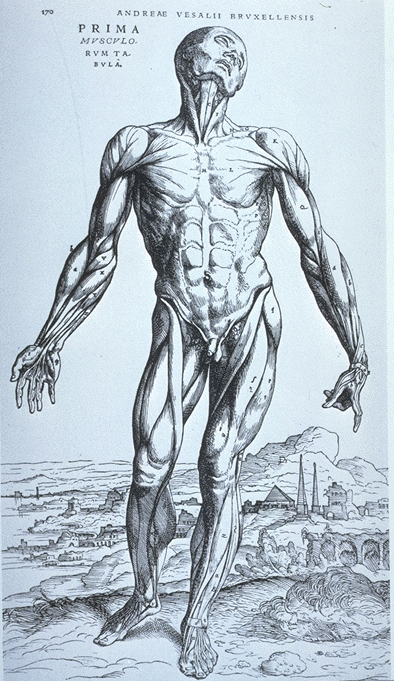11 Renaissance Natural Philosophy
Siraisi
Albala
“Renaissance science” ca. 1480 – ca. 1600
Recovery of ancient texts:
- 12th-13th centuries (universities): but not all scientific texts
- humanist movement: late phase includes scientific texts
Translation; assimilation; innovation
When experience and text do not match:
- manuscript errors
- changes in phenomenon over time
- deformities in particular object
- new phenomenon unknown to ancients
- finally: perhaps ancients were in error
Galen and anatomy
Andrea Vesalius (1514-64)
at Paris: professors inclued Johann Winter von Andernach (1505-74)
- published works included translations of 5 of Galen’s works 1529-39
- Vesalius assisted in editing work

On the use of the parts known since 14th c. (pub. 1528)
Natural Faculties translated by Linacre 1523
Anatomical Procedures tr. by Vesalius’ teacher Johann Winter 1531
Greek edition of Galen opera omnia 1525 (Venice: Aldus Manutius)
Vesalius: De humani corporis fabrica libri septem (Seven Books on the Structure of the Human Body) 1543


Led to a great increase in use of dissection for research, instruction
Career success:
became physician to Charles V, Philip II
an error of Galen: the rete mirabile
- Identifies error: a structure that is not there
- Identifies likely causes of error: structure is present in other mammals; ancient limits on dissections
BBC on Vesalius with Prof. Sachiko Kusukawa
Galen, De alimentorum facultatibus translated, published 1530
Pliny: Natural History
Gaius Plinius Secundus (CE 23/24–79) Historia Naturalis
Always accessible, read
Pliny in the Renaissance (1470-1600 ca)
- Interest in Pliny as writer and person not just contents
- Textual accuracy
- use of Greek terms
- Use of and references to many (lost) authors
- Innovations in the study of nature
Print: 1470 Venice and Rome (Sweynheim)
1472 printing of Pliny’s Natural History
ornamented for the Medici
1476: Jenson, Venice sponsored by Strozzi family (Florence). Trans. Cristoforo Landino.

The “Errors of Pliny” debate
- 1492: Niccolo Leoniceno (1428-1524) De Plinii et plurium aliorum medicorum in medicina: professor of medicine, Ferrara
- inaccuracies in terms Greek-Latin-modern
natural sympathies as explanation of effects
Qualities (“virtues”)
Antiquarian interest: mid 16th century
Botany
Study of pharmacy at universities

Dioscorides (d. 90 CE), Materia medica (Spanish), Antwerp 1555
chairs at Italian universities by 1530s, 1540s, then across Europe
Botanical gardens: Pisa, Padua 1544 Plan of the Botanical Garden, Florence, 1545-6

- Field trips
- New World finds
- Herbaria; Natural history museums.
- Efforts at classification

Leonhart Fuchs, 1501-1566. Laebliche abbildung und contrafaytung aller kreuter. Basel: Durch Michel [sic] Isingrin, 1545. [266]-267. (UW-Madison)




